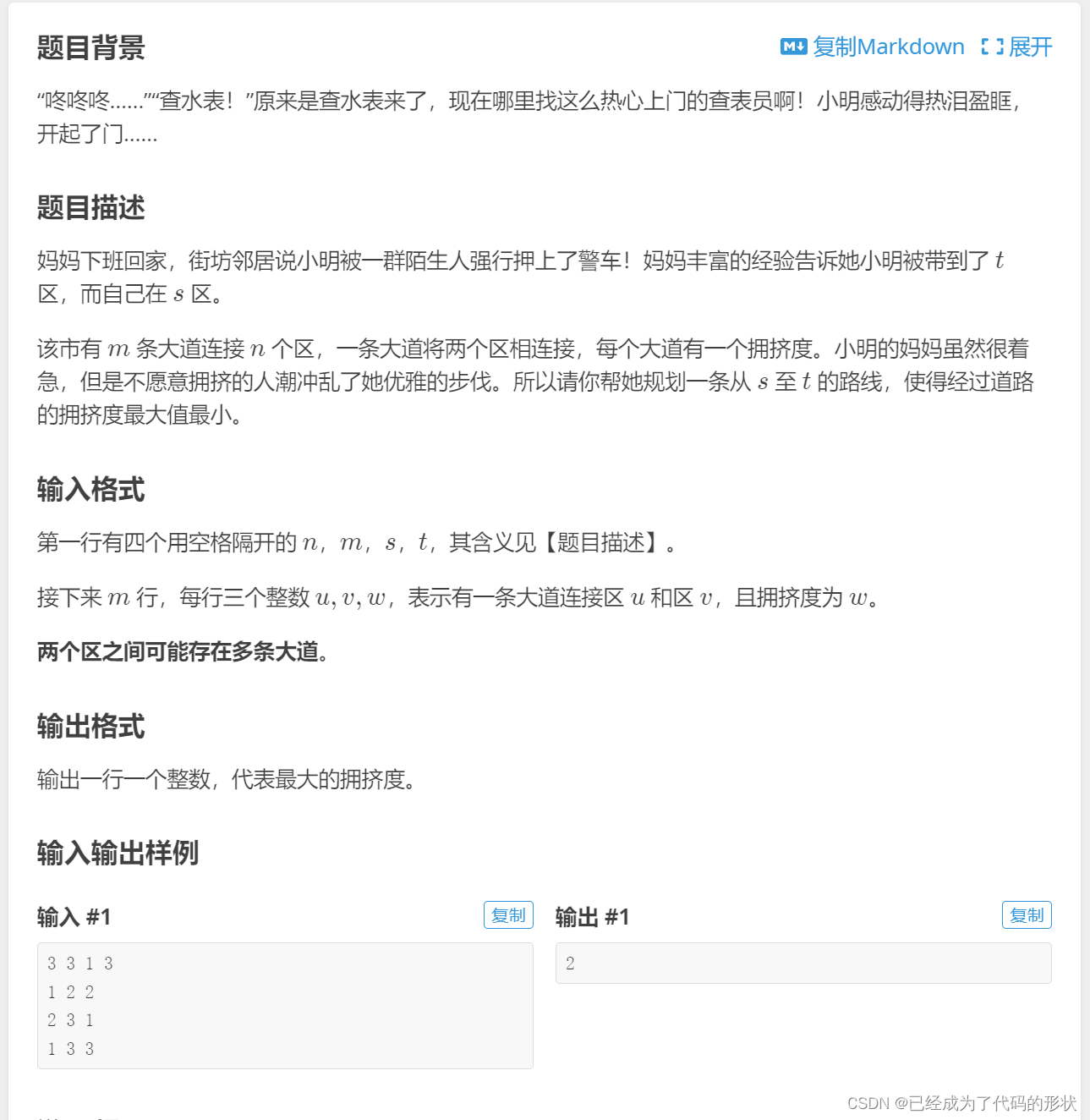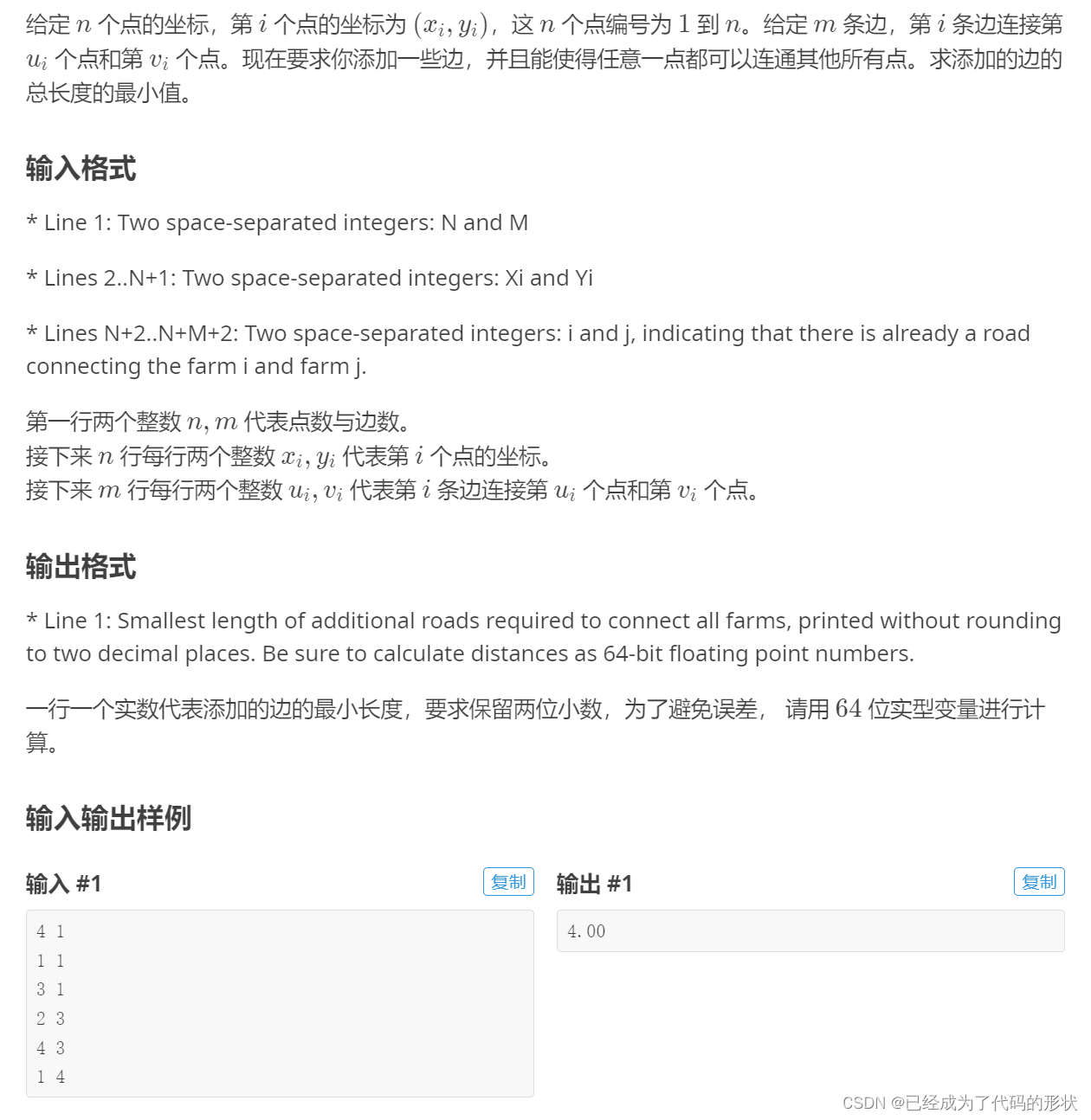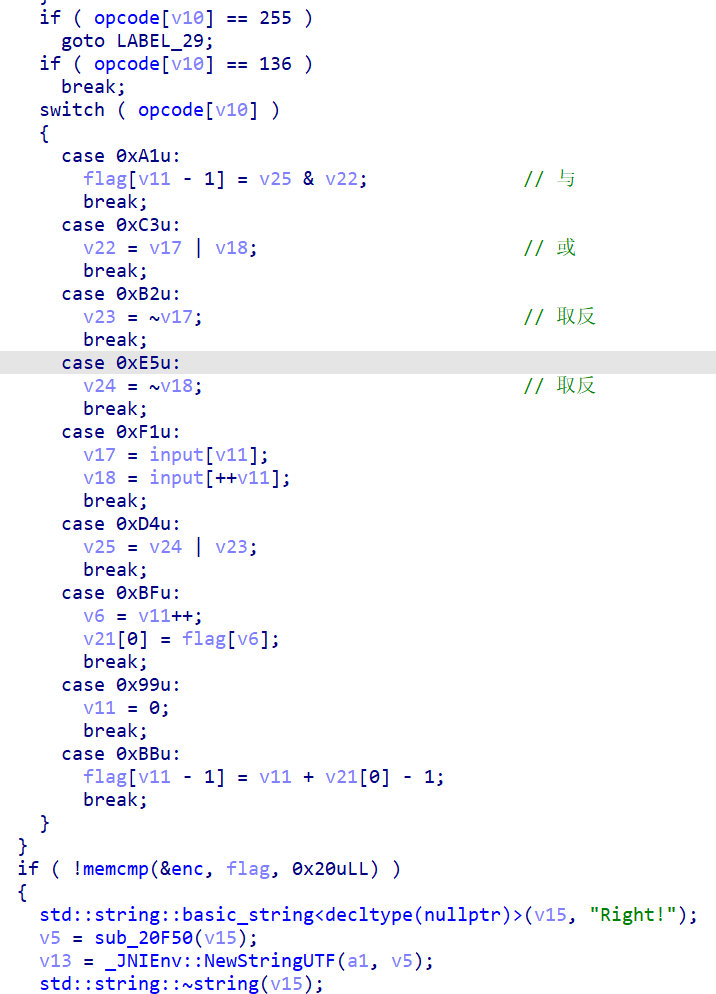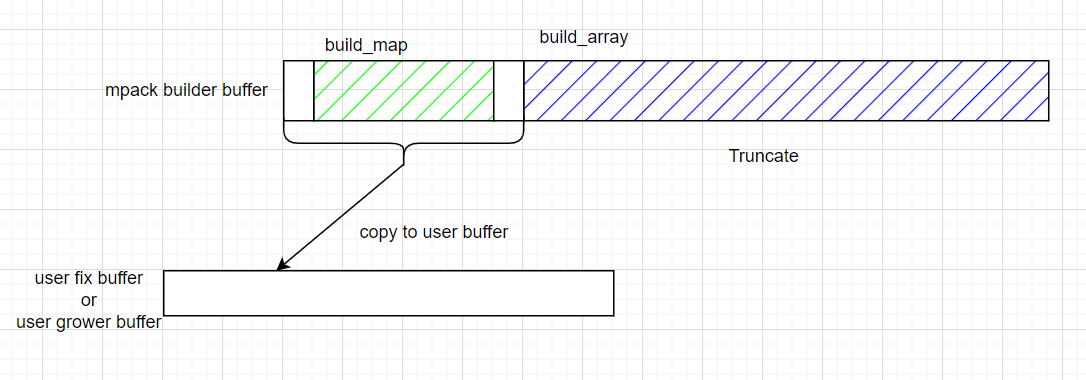1.Kruskal算法概念以及基本思路
(1)概念:
克鲁斯卡尔算法是求连通网的最小生成树的另一种方法。它的时间复杂度为O(ElogE)(E是图G的边的总数),适合于求边稀疏的网的最小生成树 。
其基本思想是:假设连通网G,令最小生成树的初始状态为只有n个顶点且没有任何一条边的图T,概述图中每个顶点自成一个连通分量。在E中选择代价最小(即距离最短)的边,若该边依附的顶点分别在T中不同的连通分量上,则将此边加入到T中;否则,舍去此边而选择下一条代价最小的边。换而言之就是在整个图找最短的边,从短到长一次寻找,若没有连通,则进行连通,若已经连通,则放弃这个边,去寻找下一个,知道变成连通图
(2)基本思路:
从它的基本思想我们可以得出做题时的基本思路:
1.首先创建一个一维数组,用于判断这个点是否连通,每个数组的初始值都对应自己的下标
2.创建一个结构体,存储位置信息,以及之间的长度
3.通过快排进行排序,将路径最短的排在前面
4.根据题解去寻找最小生成树
2.相关例题
第一题:最小生成树

题解:这题就是最基本的最小生成树问题,没有什么难度
#include<bits/stdc++.h>
using namespace std;int n,m;//n个结点和m条边
struct lu//代表路径的结构体
{int start;//起始节点int end1;//终止结点int l;//路径长度
}q[200005];
int f[50005];//用于判断是否连通的数组
int count1;//统计已经连通几条边
long long sum;//总长度int cha(int x)//查,判断是否属于同一个根节点
{if(f[x]==x)return x;return cha(f[x]);
}void bing(int root1,int root2)//并,将根节点并在一起
{if(root1==root2)return;f[root2]=root1;
}bool cmp(lu a,lu b)//路径要根据路径长度进行比较
{return a.l<b.l;//快排顺序,从小到大排列路径长度
}int main()
{scanf("%d%d",&n,&m);for(int i=1;i<=n;i++){f[i]=i;//将根节点设置为自己}for(int i=0;i<m;i++){scanf("%d%d%d",&q[i].start,&q[i].end1,&q[i].l);}sort(q+1,q+m+1,cmp);//快排for(int i=0;i<m;i++){if(cha(q[i].start)==cha(q[i].end1))//如果已经并在一起就直接跳过continue;bing(cha(q[i].start),cha(q[i].end1));sum+=q[i].l;count1++;if(count1==n-1)//当满足了连通图,这个是连通图的性质,边数=顶点数-1break;}if(count1<n-1)//如果是非连通图{printf("orz");return 0;}printf("%d",sum);return 0;
}第二题:拆地毯

题解:这题其实就是最小生成树的地方略变一点儿,求的是最大生成树,我们要找的是最长的长度,那么我们只需要改变一下快排的方式即可
AC代码:
#include<bits/stdc++.h>
using namespace std;
int n,m,k;
struct lu
{int start;int end1;int l;
}q[100005];
int f[100005];
int count1;
int sum;
int cha(int x)
{if(f[x]==x)return x;return cha(f[x]);
}
void bing(int root1,int root2)
{if(root1==root2)return ;f[root2]=root1;
}
bool cmp(lu a,lu b)
{return a.l>b.l;//改变一下快排的方式
}
int main()
{scanf("%d%d%d",&n,&m,&k);for(int i=1;i<=n;i++)f[i]=i;for(int i=0;i<m;i++){scanf("%d%d%d",&q[i].start,&q[i].end1,&q[i].l);}sort(q,q+m,cmp);for(int i=0;i<m;i++){if(cha(q[i].start)==cha(q[i].end1))continue;bing(cha(q[i].start),cha(q[i].end1));count1++;sum+=q[i].l;if(count1==k)//当保留的地毯满足保留的个数结束就可以break;}printf("%d",sum);return 0;
}第三题:无线通讯网

题解:也是最小生成树类的题目,但是没什么的,唯一改变的地方就是因为这个地方不是求路径和,而是卡的最小的无线电所需要的距离,也就是卡的极限最小值
#include<bits/stdc++.h>
using namespace std;
int s,p;
int x[505],y[505];
int f[1000005];
struct lu
{int start;int end1;double l;
}q[2000005];
int count1;
double sum;
int cha(int x)
{if(f[x]==x)return x;return cha(f[x]);
}
void bing(int root1,int root2)
{if(root1==root2)return ;f[root2]=root1;
}
bool cmp(lu a,lu b)
{return a.l<b.l;
}
int main()
{int flag=0;scanf("%d%d",&s,&p);for(int i=1;i<=p;i++)f[i]=i;for(int i=1;i<=p;i++){scanf("%d%d",&x[i],&y[i]);for(int j=1;j<i;j++){flag++;q[flag].start=i;q[flag].end1=j;q[flag].l=sqrt((x[i]-x[j])*(x[i]-x[j])+(y[i]-y[j])*(y[i]-y[j]));}}sort(q+1,q+1+flag,cmp);for(int i=1;i<=flag;i++){if(cha(q[i].start)==cha(q[i].end1))continue;sum=q[i].l;//长度就是那个极限的值bing(cha(q[i].start),cha(q[i].end1));count1++;if(count1==p-s)//当满足了结束条件break;}printf("%.2lf",sum);return 0;
}第四题:营救

题解:也是最小生成树的题目和第三题其实一样,只不过排的是拥挤度
AC代码:
#include<bits/stdc++.h>
using namespace std;
int n,m,s,t;
struct lu
{int start;int end1;int l;
}q[20005];
int f[10005];
int count1;
int sum;
int cha(int x)
{if(f[x]==x)return x;return cha(f[x]);
}
void bing(int root1,int root2)
{if(root1==root2)return ;f[root2]=root1;
}
bool cmp(lu a,lu b)
{return a.l<b.l;
}
int main()
{scanf("%d%d%d%d",&n,&m,&s,&t);for(int i=1;i<=n;i++)f[i]=i;for(int i=0;i<m;i++){scanf("%d%d%d",&q[i].start,&q[i].end1,&q[i].l);}sort(q,q+m,cmp);for(int i=0;i<m;i++){bing(cha(q[i].start),cha(q[i].end1));sum=q[i].l;if(cha(s)==cha(t)){break;}}printf("%d",sum);return 0;
}第五题:买礼物

题解:这题有一个坑,就是有可能绑定在一起买比单个买还要贵,因此我们在进行价值的计算时需要有一个判断
#include<bits/stdc++.h>
using namespace std;
int a,b;
struct wu
{int x,y;int w;
}q[250005];
int f[505];
int sum;
int count1;
int cha(int x)
{if(f[x]==x)return x;return cha(f[x]);
}
void bing(int root1,int root2)
{if(root1==root2){return ;}f[root2]=root1;
}
bool cmp(wu a,wu b)
{return a.w<b.w;
}
int main()
{scanf("%d%d",&a,&b);sum=a;for(int i=1;i<=b;i++)f[i]=i;for(int i=1;i<=b;i++){for(int j=1;j<=b;j++){count1++;scanf("%d",&q[count1].w);q[count1].x=i;q[count1].y=j;if(q[count1].w==0)q[count1].w=a;}}sort(q+1,q+1+count1,cmp);for(int i=1;i<=count1;i++){if(cha(q[i].x)==cha(q[i].y))continue;bing(cha(q[i].x),cha(q[i].y));sum+=min(q[i].w,a);//去优惠价格和原价格的小值}printf("%d",sum);return 0;
}第六题:Building Roads S
 题解:这题也是很简单的和无线电那个在处理坐标的方式差不多,但是恶心的地方在于精度的把控,需要在原本的精度上更加细致不然还是会WA,血的教训,也是一开始就中计了啊,大意了,没有闪
题解:这题也是很简单的和无线电那个在处理坐标的方式差不多,但是恶心的地方在于精度的把控,需要在原本的精度上更加细致不然还是会WA,血的教训,也是一开始就中计了啊,大意了,没有闪












